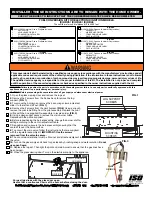
040515-24
17
©PACIFIC ENERGY FIREPLACE
PRODUCTS LTD.
OPERATING TIPS
1. Always use dry, seasoned fi rewood, up to 18"(457mm) long.
Load wood, a mixture of large and small pieces, on top of a
good ash base (1"(25mm) minimum).
2. Operate on a medium to high setting, for up to 1 hour from
cold start. After the initial warm up period, refuel and leave
the air control on a medium setting for 5 to 10 minutes more
and then set the air control to the desired position.
3. If a slow burn is desired, set the air control to low. Active
secondary burning should be
present above the wood load.
If it is not present or goes out
shortly after, proper operat-
ing temperature has not been
reached and the stove needs
additional warm up time.
Understanding & Operating Your Pacifi c Energy Stove
The Pacifi c Energy line of woodstoves is a culmination of
years of research and development. Designed to be efficient,
clean-burning and user-friendly, this heater will give you years
of warm service. However, a knowledgeable operator is still
the most important factor for maximum performance and part
of this is understanding the basic functions of this design.
Traditional wood stoves had a basic combustion system which
allowed a considerable amount of heat energy to escape up
the chimney as unburned gases and particulates (smoke).
Pacifi c Energy has designed a system that solves the prob-
lem by burning the smoke and releasing the additional heat
to the room.
This system has two critical design
features:
1.
Above fi re secondary air injec-
tion:
The hollow "air baffle" injects
super-heated secondary air just
above the load. With the stove at
the proper operating temperature,
this will create a secondary fl ame
that will be evident for approxi-
mately 1/3 of the total burn time.
2.
High mass and thermal insula-
tion:
The high mass (weight) acts as
a heat storage and the thermal
insulation keeps the combustion
zone hot. Active fl aming takes
place during the fi rst part of the
burn. During this stage, heat is
stored in the mass of the unit
and is later released slowly and
evenly. As wood chars, active
fl aming will diminish. This clean
charcoal burning stage will last for a considerable length of
time and refuelling should be avoided until the charcoal base
has become quite small.
1
2
3
5
6
4
1 -Boost Air
4 -Secondary Combustion Zone
2 -Main Combustion Air
5 -Radiant Heat
3 -Air Wash System
6 -Convected Heat








































